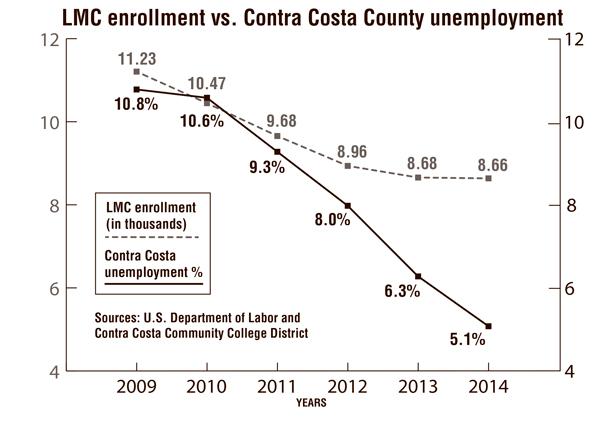Down goes enrollment
Better economy jilts attendance

Graphic by Damian Lewin
There’s good news and bad news at the Contra Costa Community College District.
The good? The economy continues to rebound. The bad? As a partial result, student enrollment is down again for the third consecutive year.
The estimated total number of full-time equivalent students registered in the district for the 2014-15 fiscal year is 26,993.30. This number falls short of the 28,367 goal.
Reasons for the decline vary, although one theory is that the economy is improving.
Analysis of U.S. Department of Labor statistics and information provided by the district chancellor’s office suggests a positive correlation can be drawn that shows that as the unemployment rate falls, as it has from 10.8 to 5.1 percent between the years 2009 and 2014, enrollment figures for the district having fallen as well (see accompanying).
“Students that are working tend to take fewer units, and some choose not to take any classes,” said Los Medanos College Vice President Kevin Horan. “This is a good thing, but it does have an impact on our enrollments.”
Horan said he believes a recent change in course repeatability regulations is also having an impact on the number of enrolled students.
“There are limitations for the number of times a student can take a course through academic renewal, as well as limitations on activity-based courses, which were wildly popular with students that were not necessarily attending LMC for a degree or certificate,” he said. “Courses in PE, drama, art and music were particularly impacted.”
The resulting gap of 1,373.70 in projected full-time equivalent students (FTES) is important, as it directly relates to the amount of money that the district receives to distribute to the colleges.
Community colleges are funded approximately $4,600 for each FTES, which is figured using a state formula based on the total number of students enrolled. The problem is that colleges are not paid based on student enrollment in the current year, but on a projection of what student enrollment will be the next year. If the projection is not met, the district may end up having to pay money back the state for funds paid up front for students it did not serve.
The current enrollment disparity translates to an estimated $6,368,473 potential loss in district funding.
The district prepared for this drop in enrollment by borrowing FTES numbers from the summer semester, and by also using temporary state stability funding. The strategy will prevent it from seeing an actual decline in revenue.
“The district did not experience any negative financial impact from its FTES shortfalls during the past two fiscal years, nor will it experience a revenue decline in the current fiscal year,” wrote district Chancellor Helen Benjamin in an email detailing the downward trend in attendance.
But the trend is something the district is concerned about and it can also be seen in the current headcount at Los Medanos College.
The number of full-time equivalent students enrolled at LMC for the 2014-15 fiscal year, 7,572.88, represents a 33.6 percent drop from 2009 levels when 11,410 students attended the college.
Stability funding, used in the 2012-13 fiscal year, will also be used this year, allowing the college to counter-act the potential shortfall of $825,764 in funding due to not making the projected FTES goal for the year. It’s important to understand that while LMC has not reached its goals for the past few years, the disparity between actual and projected enrollment continues to shrink, explained Horan.
He added that the numbers for this year while still not what the college hoped them to be shortened the gap from the previous year.
“Our goal for 2015-16 is to make up the remaining balance,” said Horan.
LMC has been working the past few years to bring retention, the number of students who remain enrolled semester to semester, up to new levels.
“We have strategically expanded our course offerings at the Brentwood Center,” said Horan. “We have expanded the number of courses being offered in English and math that enable students to accelerate through the remedial level course to college level courses.
“In short, there is an incredible amount of energy and effort being put into enrollment management,” concluded Horan.

Hi! My name is Joseph Delano. I am 27-years-old, hailing all the way from Bethel Island. I have been at Los Medanos College for 8 years… for you math...










